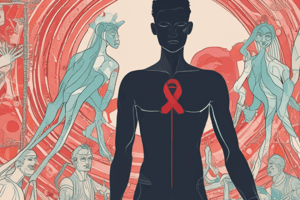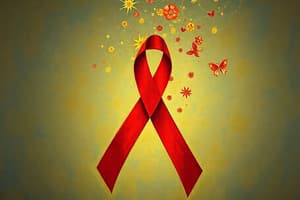Podcast
Questions and Answers
Which class of antiretroviral medications works by preventing the HIV virus from inserting its viral DNA into the host cell's DNA?
Which class of antiretroviral medications works by preventing the HIV virus from inserting its viral DNA into the host cell's DNA?
- Integrase inhibitors (correct)
- Nonnucleoside reverse transcriptase inhibitors
- Protease inhibitors
- Fusion inhibitors
A client with HIV is prescribed a medication regimen that includes a combination product. What is the primary benefit of using a combination antiretroviral medication?
A client with HIV is prescribed a medication regimen that includes a combination product. What is the primary benefit of using a combination antiretroviral medication?
- It targets a broader range of viral subtypes with fewer side effects.
- It simplifies the medication regimen by combining two or more antiretroviral drugs into a single dose. (correct)
- It reduces the risk of medication interactions by combining multiple drugs into one pill.
- It increases the potency of a single medication.
A nurse is educating a client newly diagnosed with HIV about infection prevention. Which of the following is the MOST important instruction to emphasize?
A nurse is educating a client newly diagnosed with HIV about infection prevention. Which of the following is the MOST important instruction to emphasize?
- Avoid all public places to prevent exposure to infections
- Only consume cooked foods to avoid foodborne illnesses
- Use barrier protection when engaging in any type of physical contact with others
- Maintain strict hygiene practices such as frequent handwashing (correct)
When is it appropriate for a nurse to disclose a client's HIV status to healthcare team members?
When is it appropriate for a nurse to disclose a client's HIV status to healthcare team members?
A nurse is educating at-risk individuals about HIV. What is one crucial action the nurse should encourage to promote early detection and intervention?
A nurse is educating at-risk individuals about HIV. What is one crucial action the nurse should encourage to promote early detection and intervention?
Which body fluid is NOT typically associated with HIV transmission?
Which body fluid is NOT typically associated with HIV transmission?
A patient with a new HIV diagnosis asks about ways to prevent transmission. Which action indicates a need for further teaching?
A patient with a new HIV diagnosis asks about ways to prevent transmission. Which action indicates a need for further teaching?
What is the primary purpose of the Western blot test in the context of HIV?
What is the primary purpose of the Western blot test in the context of HIV?
Which of the following is a common opportunistic infection associated with HIV, and also the leading cause of death among people with HIV worldwide?
Which of the following is a common opportunistic infection associated with HIV, and also the leading cause of death among people with HIV worldwide?
What is the most appropriate first action for a healthcare worker who experiences a needlestick injury from a patient with HIV?
What is the most appropriate first action for a healthcare worker who experiences a needlestick injury from a patient with HIV?
Which symptom is LEAST associated with HIV-associated neurocognitive disorders (HAND)?
Which symptom is LEAST associated with HIV-associated neurocognitive disorders (HAND)?
A patient presents with purple lesions on their lower extremities and face. Which opportunistic infection is MOST suspected?
A patient presents with purple lesions on their lower extremities and face. Which opportunistic infection is MOST suspected?
Which of the following symptoms is MOST suggestive of non-Hodgkin lymphoma in a person with AIDS?
Which of the following symptoms is MOST suggestive of non-Hodgkin lymphoma in a person with AIDS?
Flashcards
How is HIV Transmitted?
How is HIV Transmitted?
HIV can be transmitted through bodily fluids like blood, CSF, peritoneal fluid, breast milk, and amniotic fluid.
Can HIV be spread through casual contact?
Can HIV be spread through casual contact?
HIV is not spread through casual contact, like shaking hands.
What are the risks of HIV transmission for healthcare workers?
What are the risks of HIV transmission for healthcare workers?
Healthcare workers can be exposed to HIV through accidental needle sticks or contact with contaminated fluids.
How is HIV spread through shared needles?
How is HIV spread through shared needles?
Signup and view all the flashcards
How is HIV diagnosed?
How is HIV diagnosed?
Signup and view all the flashcards
What is Pneumocystis jiroveci pneumonia?
What is Pneumocystis jiroveci pneumonia?
Signup and view all the flashcards
What is a leading cause of death for people with HIV?
What is a leading cause of death for people with HIV?
Signup and view all the flashcards
What is Kaposi's sarcoma?
What is Kaposi's sarcoma?
Signup and view all the flashcards
Antiretroviral Medications
Antiretroviral Medications
Signup and view all the flashcards
Fusion Inhibitors
Fusion Inhibitors
Signup and view all the flashcards
Transmission Prevention
Transmission Prevention
Signup and view all the flashcards
Recognizing Symptoms of Infections
Recognizing Symptoms of Infections
Signup and view all the flashcards
Confidentiality and Disclosure of HIV Status
Confidentiality and Disclosure of HIV Status
Signup and view all the flashcards
Study Notes
HIV Transmission
- HIV is not spread through casual contact.
- Transmission occurs through specific bodily fluids: blood, cerebrospinal fluid, peritoneal fluid, breast milk, and amniotic fluid.
- Healthcare workers risk exposure through sharps, needles, or contact with infected fluids.
- Patients need education on transmission methods: sharing needles, unsafe sex, vertical transmission (mother to child), and blood transfusions (foreign blood donations may pose greater risk).
- Individuals with HIV can transmit the virus even without symptoms.
Prevention Strategies
- Consistently and correctly use condoms.
- Support accessible and clean needle programs.
- Provide comprehensive education on transmission methods.
- Use Post-Exposure Prophylaxis (PEP) kits when needed.
- Educate pregnant and breastfeeding mothers about mitigating transmission risk.
Diagnosing HIV
- Symptoms: Fatigue, fever, weight loss, wasting syndrome, night sweats, sore throats, opportunistic infections.
- Screening: HIV IgG antibody test.
- Confirmation: Western blot.
- Availability: Home test kits (oral swabs) are available.
Opportunistic Infections
- Pneumocystis jiroveci Pneumonia (PJP): Previously known as Pneumocystis carinii pneumonia.
- Tuberculosis (TB): Leading cause of death from HIV globally.
- Cryptosporidium parvum: Causes watery diarrhea.
- Other GI Infections: Salmonella, cytomegalovirus (CMV), Clostridium difficile (C. diff), E. coli, Shigella, Giardia.
- HIV-Associated Neurocognitive Disorders (HAND): Includes toxoplasmosis and HIV-associated dementia.
- Kaposi's Sarcoma: Purple, red, or brown skin tumors (often legs or face). Severe if in lungs, liver or GI tract.
- Lymphoma: Non-Hodgkin lymphoma is common in AIDS patients. Symptoms include fevers, night sweats, and weight loss.
Medications
- Antiretrovirals: Nucleoside/nucleotide reverse transcriptase inhibitors, nonnucleoside reverse transcriptase inhibitors, protease inhibitors, fusion inhibitors, integrase inhibitors, and combination products.
Caring for Clients with HIV/AIDS
- Medication Compliance: Emphasize the importance of adherence to medication schedules.
- Education: Teach about transmission prevention, recognizing infection symptoms, and managing complications.
- Infection Prevention: Guide clients on infection avoidance and hygiene.
- Confidentiality: Follow facility policies for disclosure of HIV status to healthcare team members.
- Nurse Responsibilities: Provide compassionate, considerate care, educate themselves and colleagues about HIV, encouraging screening for at-risk individuals and knowing PEP kit locations.
Studying That Suits You
Use AI to generate personalized quizzes and flashcards to suit your learning preferences.




